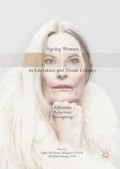Abstract
This chapter argues that in Age of Iron, J.M. Coetzee subverts the notion of dependency associated with the concepts of childhood, femininity and older age and thus releases his elderly female protagonist from the enervation conventionally associated with senescence. This is achieved by inscribing the aged female body with images of childhood that disrupt the hegemonic flow of sequential, linear time. Instead, the novel posits that both childhood and older age could be read as mutable signs that resist the inscription of rigid social meanings. In the context of South Africa’s transition to democracy, the elderly female body could be seen as representative of the irony underlying the complex, paradoxical tensions governing societal change and the impetus towards ideologies centred on newness and youthfulness.
Access this chapter
Tax calculation will be finalised at checkout
Purchases are for personal use only
Notes
- 1.
- 2.
- 3.
Cf. Edelman’s No Future (2004) for a critique of discourses that employ the image of the child in this manner.
- 4.
“Phone the ambulance” (my translation).
- 5.
“She can just wait at the station” (my translation).
- 6.
“She has lost her mind” (my translation).
Works Cited
Bakhtin, M.M. 1965; 1984. Rabelais and His World, trans. Iswolsky, H. Bloomington, Ind: Indiana University Press.
Beauvoir, Simone de. 1949. Le Deuxième Sexe. trans. H.M. Parshley 1973. London: Vintage.
Brittan, Alice. 2010. Death and J.M. Coetzee’s Disgrace. Quarterly 26 (3): 441–450.
Burman, Erica, and Jackie Stacey. 2010. The Child and Childhood in Feminist Theory. Feminist Theory 11 (3): 227–240.
Coetzee, J.M. 1980. Waiting for the Barbarians. London: Secker & Warburg.
Coetzee, J.M. 1990. Age of Iron. London: Secker & Warburg.
Coetzee, J.M. 1999. Disgrace. London: Secker & Warburg.
Coetzee, J.M. 2003. Elizabeth Costello. London: Secker & Warburg.
Coetzee, J.M. 2005. Slow Man. London: Secker & Warburg.
Coetzee, J.M. 2007. Diary of a Bad Year. London: Random House.
Douglas, Mary. 1996. Purity and Danger. London: Routledge & Kegan Paul.
Edelman, L. 2004. No Future: Queer Theory and the Death Drive. Durham: Duke University Press.
Gramsci, A. 1971. Selections from the Prison Notebooks of Antonio Gramsci, trans. Quentin Hoare and Geoffrey Nowell Smith. London: Lawrence & Wishart.
Harris, D. 1988. Dictionary of Gerontology. Westport, CN: Greenwood.
Head, Dominic. 1997. J.M. Coetzee. Cambridge: Cambridge University Press.
Hendricks, Jon, and Cynthia Leedham. 1987. Making Sense of Literary Aging: Relevance of Recent Gerontological Theory. Journal of Aging Studies 1 (2): 187–208.
Henneberg, S.B. 2006. Of Creative Crones and Poetry: Developing Age Studies through Literature. National Women’s Studies Association Journal 18 (1): 106–125.
Hepworth, Mike. 1996. “William” and the Old Folks: Notes on Infantilisation. Ageing & Society 16: 423–441.
Kimuna, S.R., and M. Makiwane. 2008. Older People as Resources in South Africa. Journal of Aging & Social Policy 19 (1): 97–114.
Kinsella, K., and M. Ferreira. 1997. Aging Trends: South Africa. USA: U.S. Department of Commerce.
Lury, K. 2010. The Child in Film: Tears, Fears and Fairy Tales. London: I.B. Tauris.
Makiwane, M., C. Ndinda, and H. Botsis. 2012. Gender, Race and Ageing in South Africa. Agenda 26 (4): 15–28.
Marais, Michael. 1993. Who Clipped the Hollycocks?: J.M. Coetzee’s Age of Iron and the Politics of Representation. English in Africa 20 (2): 1–24.
McClintock, Anne. 1995. Imperial Leather: Race, Gender and Sexuality in the Colonial Contest. New York: Routledge.
Nashef, Hania A.M. 2009. The Politics of Humiliation in the Novels of J.M. Coetzee. London: Routledge.
Pretorius, Antoinette. 2015a. Bodily Disintegration and Successful Ageing in Body Bereft by Antjie Krog. Tydskrif vir Letterkunde 52 (2): 21–32.
Pretorius, Antoinette. 2015b. To Eke Out the Vocabulary of Old Age: Literary Representations of Ageing in Transitional and Post-transitional South Africa. PhD thesis. University of Pretoria, South Africa.
Rust, Martha, and Suzanne England. 2015. Sweet Old Things: Moral Complexities in Old Age in Muriel Spark’s Memento Mori. Journal of Aging Studies 33: 76–85.
Sadie, J.L. 1994. Economic Implications of Demographic Ageing in South Africa. Southern African Journal of Demography 4 (1): 40–57.
Sagner, A. 2000. Ageing and Social Policy in South Africa: Historical Perspectives with Particular Reference to the Eastern Cape. Journal of Southern African Studies 26 (3): 523–553.
Segal, Lynne. 2013. Out of Time: The Pleasures and the Perils of Ageing. London and New York: Verso.
Sontag, Susan. 1972. The Double Standard of Aging. The Saturday Review. September 23, 1972. 29–38.
Wyatt-Brown, Anne. 1990. The Coming of Age of Literary Gerontology. Journal of Ageing Studies 4 (3): 299–315.
Zeilig, Hannah. 2011. The Critical Use of Narrative and Literature in Gerontology. International Journal of Ageing and Later Life 6 (2): 7–37.
Author information
Authors and Affiliations
Corresponding author
Editor information
Editors and Affiliations
Rights and permissions
Copyright information
© 2017 The Author(s)
About this chapter
Cite this chapter
Pretorius, A. (2017). “I Become Shameless as a Child”: Childhood, Femininity and Older Age in J.M. Coetzee’s Age of Iron . In: McGlynn, C., O'Neill, M., Schrage-Früh, M. (eds) Ageing Women in Literature and Visual Culture. Palgrave Macmillan, Cham. https://doi.org/10.1007/978-3-319-63609-2_15
Download citation
DOI: https://doi.org/10.1007/978-3-319-63609-2_15
Published:
Publisher Name: Palgrave Macmillan, Cham
Print ISBN: 978-3-319-63608-5
Online ISBN: 978-3-319-63609-2
eBook Packages: Literature, Cultural and Media StudiesLiterature, Cultural and Media Studies (R0)

